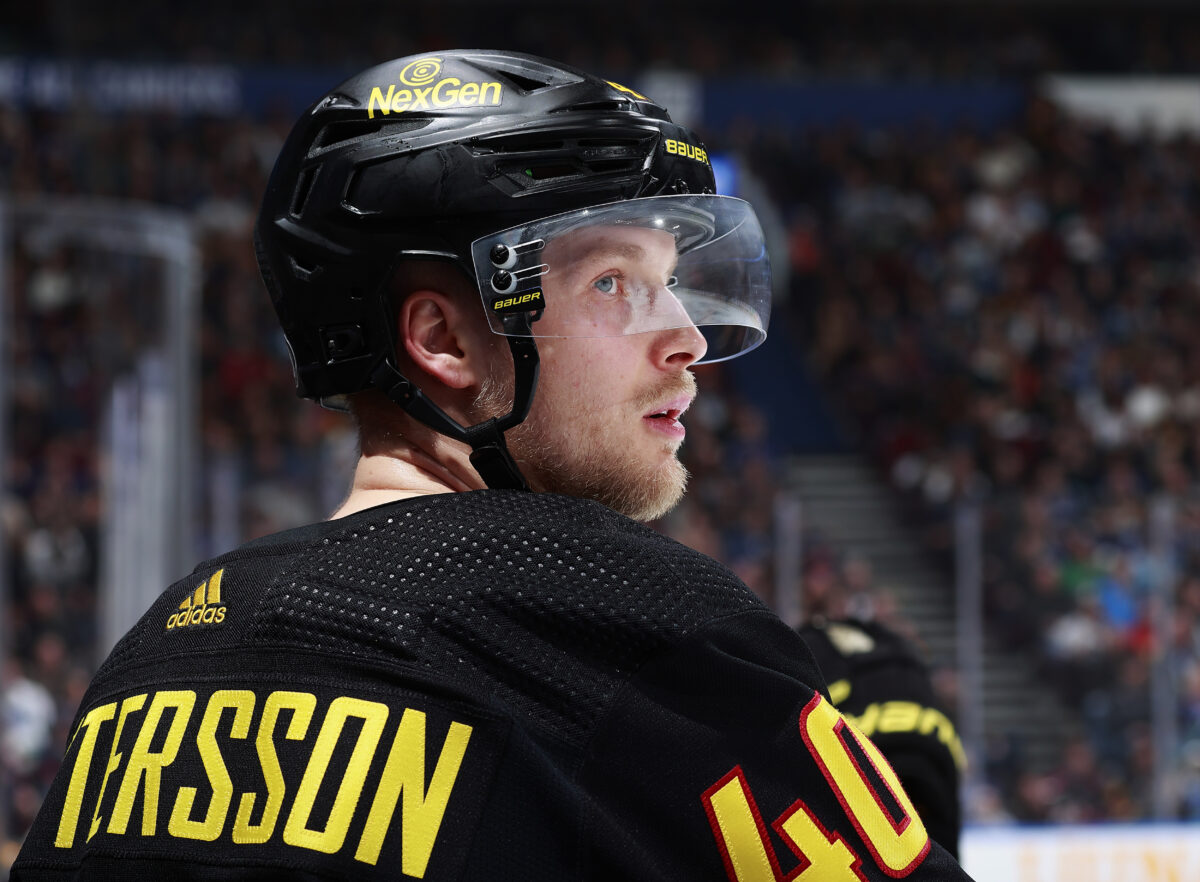On Saturday, it was announced that Vancouver Canucks’ franchise player Elias Pettersson signed an eight-year contract extension in which he will be the recipient of $11.6 million annually. He was set to become a restricted free agent after this season, and there were some questions as to whether he wanted to sign a long-term or short-term deal, or if he was going to be moved for a king’s ransom in the case that he didn’t want to return to Vancouver at all.
The Toronto Maple Leafs, meanwhile, had previously signed star winger William Nylander to a similar eight-year, $11.5 million average annual value (AAV) contract in early January. He became the fourth member of the Maple Leafs to be making an eight-figure annual salary, joining Mitch Marner, John Tavares, and Auston Matthews. Looking at the two near-twin contracts, there is a clear “winner,” though.
How Do Pettersson and Nylander Stack Up?
With contracts so comparable and signed somewhat near to each other, it is important to look at comparisons between the two to see where the Maple Leafs potentially went wrong in negotiations. There’s no doubt that Nylander is an excellent player, and as a homegrown talent has a special place in Toronto, but it does beg the question of “was it too much?”

First things first — looking at the point totals from this season and this season alone, the edge goes to Nylander, who currently sits in sixth place in the NHL with 83 points while Pettersson is in 11th with 75. The thing is, though, that this year is a bit of an outlier for Nylander, whose previous career-high in points is 87, much, much lower than the 111-point pace he’s rocking this season. Pettersson, on the other hand, has already reached the triple-digit mark, putting up 102 points last season; he’s having a down year and is still on pace for 97 points. It’s much more reasonable for a GM to put that kind of price tag on a player with prior history rather than one who is arguably breaking out this season.
Related: Maple Leafs Reportedly Still Looking for Defence Help in a Trade
Then, there’s the age factor. Nylander will turn 28 years old in May, before the season even ends. Pettersson is 25. At the end of their twin-adjacent eight-year deals, Nylander will be 36 and Pettersson 33. The Canucks, simply put, are getting more of their star’s prime than the Maple Leafs are here.
In terms of underlying analytics between the two players, Nylander does hold the advantage both on a this-season-only basis and historically, though both players are again excellent in this regard. This season alone, Nylander’s expected goals share (xGF%) of 51.78% is a reasonable amount higher than Pettersson’s 50.22%. Historically speaking is where Nylander’s advantage truly lies — the Swede, prior to this season, hadn’t held an xGF% of below 53.5% since his rookie season in 2015-16. Pettersson, meanwhile, has only reached those kinds of numbers twice in his career: last season and in 2019-20.

That, however, is more or less the only advantage Nylander has over Pettersson. Even in terms of non-statistical based analysis, the edge lies with the latter. For one, Pettersson plays a much more coveted position at center, an inherently more valuable and difficult position to be in than a winger. His defensive game is superior to Nylander’s, with his name being in the Selke conversation on an annual basis. On top of that, Nylander plays alongside far better teammates than Pettersson while still producing fewer points — just imagine how Pettersson would perform next to Matthews rather than Nils Hoglander and Pius Suter, his most recent linemates.
Auston Matthews’ Contract is Fair; Tavares’ and Marner’s Not So Much
If there’s one thing that the Pettersson extension is a testament to, it’s that Matthews’ four-year contract in which he’ll be making a league-high $13.25 million is, in fact, more than fair. Inarguably the league’s best goal scorer, Matthews fares well against Pettersson in just about every facet of his game — point production, underlying statistics, and defensive prowess favor the American-born center, and age and contract longevity are minimally concerning, especially in comparison to Nylander’s deal.
The other two, though — Marner and Tavares — present similar issues to Nylander’s contract, specifically when looking at Pettersson’s recent contract. It’s a little trickier to compare the three contracts considering the Maple Leafs’ contracts were signed in 2018 and 2019, respectively, but looking at the cap hit percentage presents a similar story to what Nylander’s contract looks like in comparison to Pettersson. For reference, Pettersson’s extension will take up 13.22 percent of the projected $87.7 million salary cap next season.

Let’s start with the less offensive of the two contracts — Marner’s — a six-year deal worth just north of $10.9 million annually, taking up 13.38 percent of that season’s salary cap. He signed it right after his entry-level contract (ELC) expired, giving the age advantage to Marner. Production-wise, Marner’s deal was more comparable to Pettersson’s than Nylander’s, and underlying statistics once again favor the Maple Leafs player. Still, positional importance and the production and history not quite being on Pettersson’s level point to the idea that then-GM Kyle Dubas could have gotten a bit more value for the Maple Leafs with that contract.
Tavares’ contract, meanwhile, is somewhat disastrous in comparison. Signed on the first day of free agency back in 2018, he was offered a seven-year, $11 million AAV contract with the Maple Leafs. To this day, he still hasn’t surpassed the 90-point mark, with his career-high prior to the contract being 86 points. His underlying statistics were up and down with the New York Islanders, with some years sporting excellent xGF% numbers and some years being well below the league average. Sure, there’s the free agent tax that the Maple Leafs likely paid, and sure, there’s that intangible leader quality that Tavares was brought in for, but that doesn’t excuse the asinine contract for someone whose production never held up to that contract’s value. It was the first mistake of many that Toronto has made in terms of contracts.
Maple Leafs Need to Move On in 2025
The Nylander contract is a perfect example of the Maple Leafs’ complacency with their players in terms of negotiations, and it certainly isn’t the first time they’ve fumbled. If they want to solidify their Stanley Cup contention window, it’s imperative that they move on from one of Tavares or Marner in the 2025 off-season. Both of their contracts will be up, and with Matthews and Nylander already making at least $11.5 million apiece starting next season, one of them needs to go. My assumption, and the correct move, is that Marner will stay put in Toronto while Tavares is forced to sign elsewhere unless he takes a significant pay cut — one that he likely doesn’t want to take. Nonetheless, it needs to be done in order for the Maple Leafs to commit to putting money into the depth scoring that they desperately need to take a run at the Cup.
